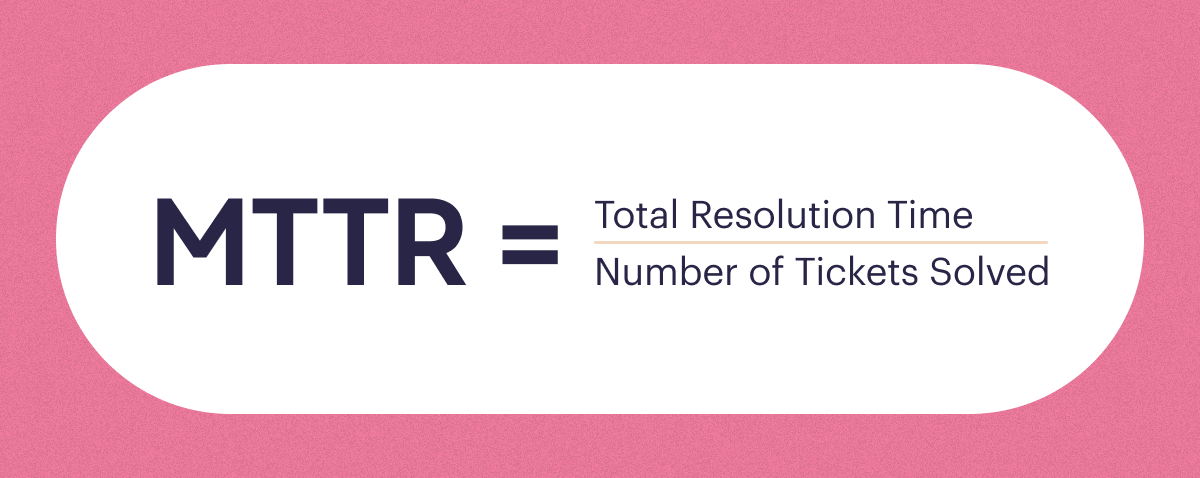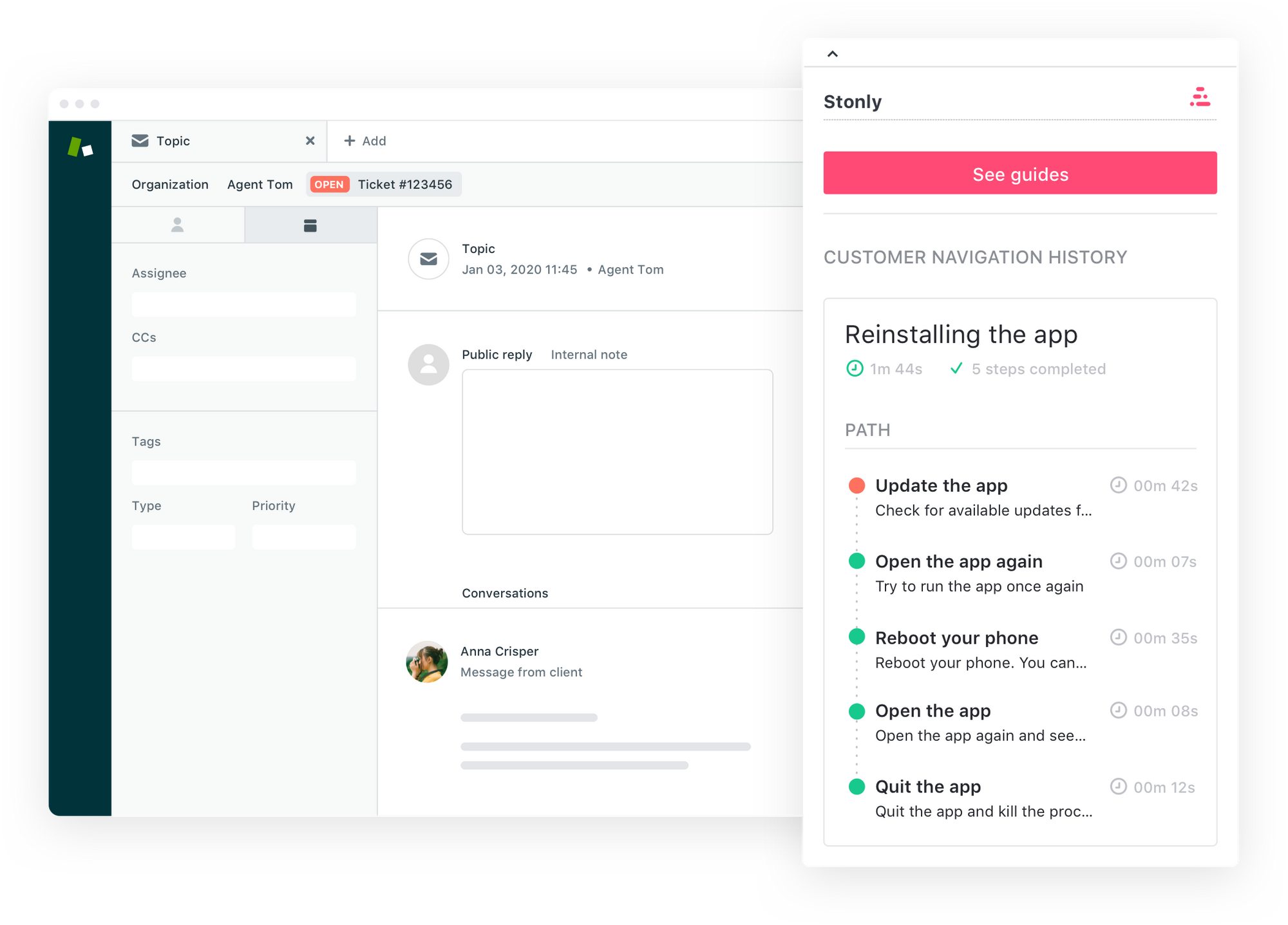What’s better? Getting quick initial help that’s incomplete or inaccurate? Or getting help that takes a little bit longer but ends up being exactly what you need on the first go?
Support teams aren’t limited to these two options, but these extremes are prevalent. And as with most things in life, each approach brings a tradeoff:
- Speed over quality: Some support teams optimize for speedy responses but aren’t effective at resolving issues. This approach prioritizes speed over quality.
- Quality over speed: Some support teams optimize for thorough responses but take significantly longer to reply to customers. This approach prioritizes quality and accuracy over speed.

If you’re a support leader, your support team falls somewhere on this spectrum. Calculating and tracking your Mean Time to Resolution (MTTR) is the best way to identify what your team is optimized for and to uncover ways to improve your customer experience.
If you’re already familiar with MTTR basics, skip ahead to this section to learn how to improve your time to resolution by creating a more seamless self-service experience.
If this is new territory for you, read on for a quick primer on this metric and why it matters for your support team.
What is mean time to resolution?
If you’re newer to this metric, the Mean Time to Resolution is the average amount of time needed to resolve a case. Support teams usually measure MTTR metrics from when a customer opens a support ticket—sending an email, starting a chat, or picking up the phone—until it’s marked as solved in your ticketing system. You’ll also hear this metric called the Average Resolution Time or Full Resolution Time.
The basic Mean Time to Resolution Formula is:

For example, say your support team solved 1,000 tickets last month. When you add up the total time all those tickets were open, you get 24,100 minutes. Your monthly MTTR metrics would be 24,100 divided by 1,000, or 24.1 minutes.
That means an average customer issue took 24.1 minutes to resolve last month. MTTR is an average, so you should remember that outliers are a factor. If you had a few tickets that took weeks to resolve, those tickets would skew your time upwards. This isn’t a problem, but it is something to be aware of if you see your numbers skewing higher or lower than usual.
Related Webinar: Go Beyond Ticket Deflection by Focusing on Self-Serve Resolutions
Why you should track time to resolution
MTTR metrics matter because they’re the best way to track your success at solving customer problems and questions. Your customers want the correct answer, but they also want you to value their time and provide help quickly.
Many support teams focus on First Response Time (FRT) as a key metric, and there’s a good reason for that. A fast first response makes a huge difference to your customer experience, according to Hubspot’s research:
90% of customers rate an "immediate" response as essential when they have a customer service question—and “immediate” means 10 minutes or less.
Optimizing for a fast first response is essential. But what if your speedy reply doesn’t solve the customer’s problem? Consider two scenarios:
- A customer reaches out, and your support team immediately responds with an incorrect or incomplete answer. This sets off a back-and-forth email conversation that takes ten messages and six hours to resolve.
- A customer reaches out and doesn’t hear back from your team for three hours, but your first response includes everything they need to know.
Which scenario is the better customer experience?
It’s a tricky question because the answer depends on the specific customer’s preferences. A lightning-quick response with a thorough and complete explanation is ideal (more on this below).
The point is that MTTR gives you the clearest picture of how effectively your support team is resolving customer problems on average. Like all customer support metrics, you shouldn’t use it in isolation, or you’ll have an incomplete picture of your customers’ experiences. MTTR metrics are most impactful when held in tension with other metrics like First Response Time or First Contact Resolution (FCR).
2 paths to lower mean time to resolution
There are two different approaches that you can take to reduce your time to resolution. You could start with your:
- Complex cases that take the longest to solve and are pushing the whole average up.
- High-volume cases that take slightly longer than average to solve.
Complex cases are low-volume but probably take forever to solve—your outliers—likely require a ton of back-and-forth responses, multiple escalations, or involving other teams like engineering. While they’re complex because they take so long to solve, your overall average can significantly decrease if you improve even a handful of these.
High-volume cases are relatively easy to handle. Shaving off some resolution time from these cases might require minor process adjustments, so it’s often the best place for support teams to start. Remember that the savings you achieve from each case won’t look impressive. Still, even a slight improvement in resolution time can significantly impact your mean time to resolution, especially if you’re tackling high-volume cases—the kind your team handles hundreds of times a week.
Here are some methods you can use to reduce the MTTR metrics on high-volume cases:
- Speed up your first response. If your first response times are the reason resolution takes long—e.g., a case sits in your queue for hours but then gets handled in minutes once assigned—then you need to focus on your queue management. This can involve adjusting case routing and assignment rules or looking at your strategy for scaling customer support.
- Provide internal training. Internal training is the right prescription if your resolution time is high due to low-quality responses or high escalation rates. Training with scripts and playbooks can equip your frontline teams to answer customers faster and more completely, reducing the time spent following up.
- Improve internal processes. Sometimes resolution times are high because you’re waiting on input from other teams. If that’s your situation, you’ll need to work with the appropriate teams within your organization to figure out better methods of communication and prioritization.
- Optimize self-serve support. Investing in self-service is the secret recipe for dramatic MTTR reductions. We’ll dive into this more below.
Related Article: 5 Things to Do When Support Volume Spikes Threaten Your Goals
The power of self-service for quick resolution times
It’s hard to overstate the importance of self-service in reducing resolution times. Let’s look at an example to contrast and highlight the impact of effective self-service in enabling quick issue resolution:
A customer has a broken item that they think is still under warranty. They’re hoping for a replacement item, so they go to the company website and search in their help center to see if they’re eligible.
A bad self-service experience:
A self-serve experience that’s not focused on improving resolution times would look something like this:
- The customer searches the knowledge base but doesn’t find any information that speaks clearly to their warranty.
- They submit a ticket through the support form, which asks for their name, email, and problem summary.
- The customer waits 48 hours for a response asking for their warranty number and proof of purchase.
- After a few emails back and forth to gather information—taking an additional two days— the support agent finally verifies their eligibility and issues the replacement.
This scenario gives you a resolution time of at least four days. Certainly not ideal, and probably really frustrating for the impacted customer. Although they ultimately got the resolution they were hoping for—a replacement—the road to get there took a long time and required a lot of effort.
This is a bare-minimum approach to self-service.
An excellent self-service experience:
But there’s a better alternative. Imagine the same customer with the same problem, also starting by visiting the company’s help center as customers have been trained to do over many years:
- They search the knowledge base to learn about warranties and find an interactive page about warranties.
- The page guides the customer step-by-step through identifying the product they want to replace, collecting their warranty number, and all other relevant information.
- Because the backend of the help center integrates into the company’s inventory, the system confirms the item is in stock in real-time.
- After confirming the availability and the customer’s address, the system issues the replacement and sends a confirmation email.
Instead of waiting days, this customer got the same resolution within minutes. What a massively different experience!
This is how you create brand loyalty and use customer experience to drive retention and future growth.
Sounds great, right? Here’s how you can get there.
3 strategies to improve your MTTR metrics this month
Great self-service solves many of the problems that make support tickets drag on for days. It goes beyond traditional customer support automation, like chatbots, which often frustrate customers. Here are three of the most straightforward solutions you can implement immediately to reduce your MTTR through self-service:
- Embed step-by-step help guides
- Make help easy to find
- Pre-qualify with custom contact forms
1. Embed step-by-step help guides
When you’re dealing with complex issues or problems that are variable—like some warranties including replacements while others don’t—it can feel like the only options are to overwhelm customers with a wall of text or have them contact your support team.
But that’s not true.
A better approach to self-service—even with complicated issues—is to create interactive guides that take your customers step-by-step through solving an issue. Help content that’s interactive and easy to follow means customers don’t drop off or reach out in frustration. This approach also lets you build out branching logic to deal with variability—such as “If the customer supplies a warranty number starting with X, show them Y. If not, show them Z.”
Stonly is built for this exact reason. The typical approach to self-service is flawed. Interactive and personalized guides are a much more human approach.

Of course, you’ll never be able to resolve 100% of issues via self-service. That’s why a smooth handoff from your self-service tool to a human agent is critical. Even in the most complex situations, interactive self-service can help you narrow down the issue and intelligently route the support ticket to the right person or team so customers won’t have to repeat themselves.
2. Make help easy to find
If your support team’s first reply to customers is normally a link to your help documentation, you’ve got an easy opportunity to reduce your resolution time by eliminating the need for those replies.
There are two common reasons why this occurs for support teams:
- Your help documentation isn’t easily accessible or searchable, so your customer didn’t find the help article before contacting support.
- Your customer looked at the article before contacting support, but the system didn’t provide that context to your support agent.
The second option is often far worse for your customer. If they have to reply and tell you they’ve already tried everything in your help center, their support journey has started off on the wrong foot.
Both of these cases are solvable.
The first step is to serve up help documentation as close to where the problem might occur as possible. When the customer needs help, it’s right there waiting for them. This makes it harder to miss.
The second step is ensuring you capture and pass over all applicable customer journey context to your support team.
Stonly does both of these things natively:
- You can place the widget on any page to proactively share personalized help where needed.
- When a customer interacts with a Stonly guide, their usage history gets captured and shared, enabling your support team to pick up the interaction right where the customer got stuck.
This reduces the back-and-forth sending of help articles and creates a more seamless handoff from your self-service process to your human team members.

3. Pre-qualify with custom contact forms
If your support tickets take longer to solve because agents frequently need to gather information, it’s a good bet that your contact forms need some work. Custom contact forms allow you to tailor the information you’re collecting from the start of the support interaction.
Many support leaders mistake contact forms as just another way for customers to reach out. That’s only partially true. Effective contact forms are an opportunity for you to understand a customer’s problem quickly so you can provide a seamless solution in response.
At Stonly, we’ve designed things to help you:
- Create custom contact forms based on which part of the product the customer is using.
- Use the customer's information to route their questions to the right person, reducing the need to reassign cases in your ticketing system.
- Integrate information from your systems to double-check order numbers or customer information against your database and take some of the load off your agents.
Each of these features empowers faster replies and faster resolution, making them a vital part of your strategy for reducing MTTR metrics.

The ripple effects of fast resolutions
Solving tickets faster has a ripple effect across your customer experience. Each step you take to reduce your mean time to resolution will likely also improve other key metrics like first reply time and first contact resolution. As you consistently deliver an improved customer experience, you’ll also see a positive impact on lagging indicators like customer satisfaction and net promoter score.
Ready to speed up your resolution times and receive glowing feedback from customers? Request a demo today.
